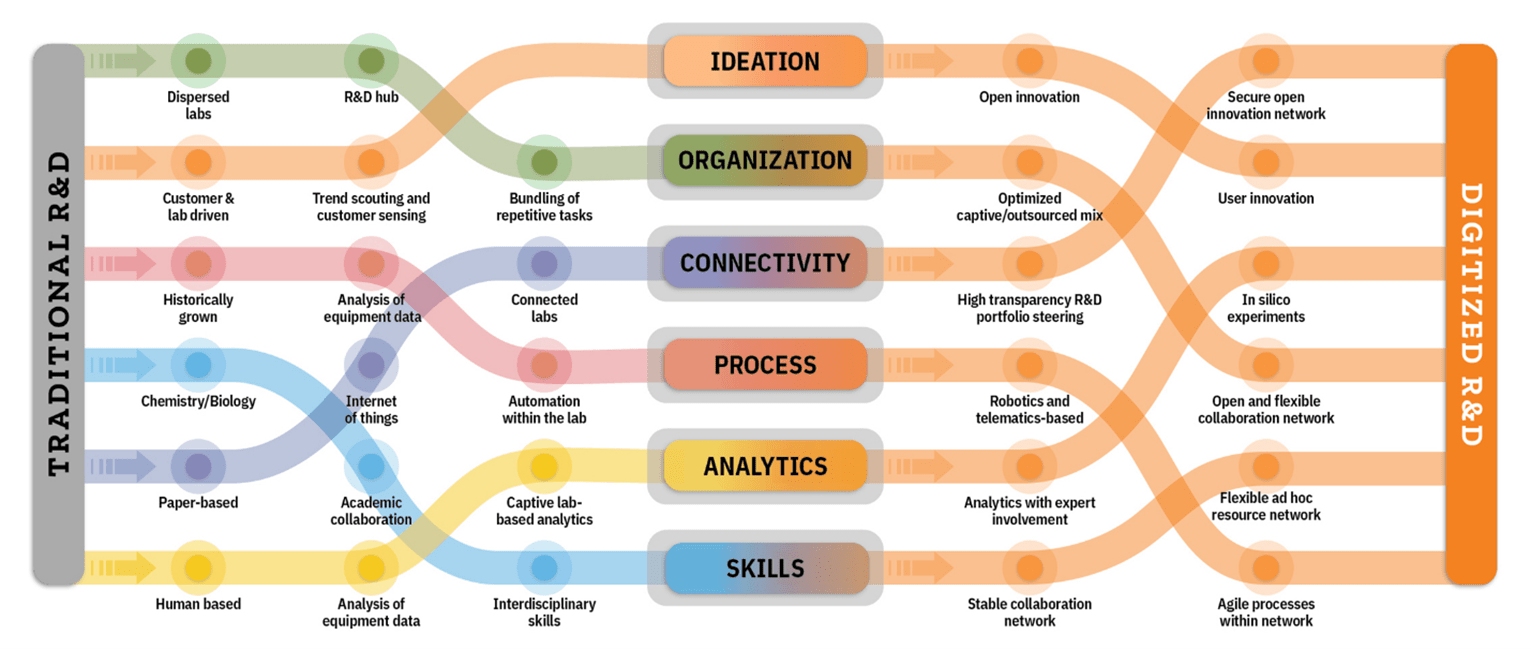
The Integrated Lab – Lab connectivity powers data-driven discovery
Article published in Lab Manager | March 2022, Vol. 17 • Number 2
By Dave Dorsett, Principal Software Architect at Astrix
Technology has changed nearly every aspect of our daily lives and has rapidly redefined the way we do science. The digital disruption brought about by the vast influx of innovative technologies has created both an increasing dependency on technology and accelerated digitally-enabled science. The emergence of the Internet of Things (IoT), artificial intelligence (AI), and machine learning (ML) provides the basis for intelligent automation and big data-driven insights.
These and other digital technologies are capable of boosting productivity and transforming operations into the lab of the future. Lab connectivity holds the key to unlocking insights powered by this digital revolution leading to the next scientific breakthrough. Still, many science-based organizations are struggling to leverage these tools.
Digital transformation of R&D embodies the principles of digitization to remove any paper-based processes, but within a framework of re-examining the entire work process. Rather than just moving the current state of data generation and capture to electronic form, digital transformation focuses on broader questions, such as what data is used by whom for what purposes, and if there is a more direct route to accomplish the scientific goal. This makes it explicitly cross-functional and opens opportunities for improvement in overall operational efficiency and productivity in the larger business processes.
How does an integrated lab work?
The concept of the integrated lab is a completely digital lab environment, where manual work is eliminated, materials and samples are transparently managed, and work processes are connected across all instruments and flow seamlessly across any operational systems needed to support the work. These digital workflows lead to overall improved data quality through automation and explicit connectivity—the operational systems share critical common metadata and expose their data for use by other systems openly and as needed. A characteristic of this type of data is referred to as a FAIR1. The four foundational principles of FAIR data are: findability, accessibility, interoperability, reusability. Data flowing into and out of the lab environment must adhere to FAIR principles to achieve the benefit of “data-readiness” from the digitally integrated lab of the future.
Disconnected systems have, thereby, become a major pain point in the lab. Managing mixed digital and non-digital processes using scientists to transport data is decreasing operational efficiency and raising questions of quality and completeness with respect to data. To overcome the challenges arising from the continued use of non-digital processes, today’s modern lab needs to re-examine fundamental data flow.
Examining the generation of data as an example, use of IoT (smart) technology to improve data collection integrity and automatically associate the intrinsic metadata of who, what, and where the data was created with the instrument results. In this future state, all lab instruments and equipment are connected to cloud storage, where it can be processed and combined with other relevant enterprise data for analysis. This improves the relationship between the instrument data and its use, and all consumers of the results are given direct access to the primary instrument data used to support the results.
As R&D organizations continue to operate with a global footprint, use outsourced CROs/CMOs services, and collaborate with external partners, the need for an integrated digital lab becomes imperative for managing the secure and compliant bi-directional flow of data across a multitude of business and informatics platforms.
Achieving lab connectivity
Digital connectivity forms the basis for transformation in lab productivity. It is common for many scientific labs to have multiple deployments of LIMS, ELNs, and analytical instrumentation that is duplicative, siloed, aging, and requires manual operation or transcription. To achieve a truly transformative lab environment, all people, processes, systems, and data must be connected and harmonized into a rational, scalable system and data architecture.
The most effective approach to a digital transformation starts with a thorough current state scientific process analysis. This involves analysis and documentation of the lab workflows in practice, including the current use of systems across current lab equipment and functions. This current state assessment provides a map of “pain points”—inefficiencies, wait states, unnecessary duplication of work and data, and manual creation or re-creation of data. This assessment then guides the development of the optimized future state work processes that includes selected process improvements arranged in a roadmap. The roadmap is important: resolving all the pain points in a single step is not pragmatic, furthermore, not all the pain points will be independent or have the same importance. In practice, resolving even some of the major issues should be reason to re-evaluate the workflow to ensure the next steps are the better ones.
The diagram below is a visual representation of the complexity of an overall digital transformation as applied to various priorities of a specific organization. Although there are different digital transformation journeys, the overall goal remains to connect workflows to move from a traditional R&D state to a true digitized R&D environment.

Without a clear strategic plan, organizations often rush to implement solutions in ways that do not support the future goals of the business. There are tools and services available in the marketplace today that provide the expertise and resources needed to analyze, plan, and execute a successful digital transformation program for your organization that will ultimately lead to increased productivity for the lab. Digital transformation is not a classic IT project. The effort involved is different from implementing a vendor system. Digital transformation is a program to re-think the way in which science is done.
Follow the data
Data is the most valuable asset of modern science. Gaining access to the insights that data hold is the key to data-driven R&D. An integrated laboratory provides the digital connectivity required to make R&D data more effective by making it available when and where it is needed. Digitization can eliminate workflows currently running on paper, Excel, PowerPoint, and email. Digital transformation, however, identifies and stratifies data based on its use and develops additional connectivity among data and the scientists who use it, allowing scientific processes to become “data-centric.” This transformation also enables advanced analytics, applying algorithms and AI/ML to automate and optimize R&D results through descriptive and predictive modeling.
Journey to the cloud
In the past decade, organizations have been adopting a “cloud-first” or “cloud-only” approach. When applied fittingly, cloud-based IT solutions offers flexible, lean, cost-efficient infrastructure that opens the door for more digitization, and hence digital transformation. The key is flexibility. Use of cloud alone may be necessary to achieve the flexibility needed to support digital transformation, but it is not sufficient.
Cloud infrastructure should permit companies to focus more on the use of technology rather than the care and feeding of the technology itself. Unfortunately, this is not always the case. In fact, cloud infrastructure in the real world can be more inflexible than using on-premise infrastructure. This irony is typically the result of the lack of transformation in the IT organization and can be a significant barrier to digital transformation.
Collaborations among global sites and external business partners require moving enormous amounts of data quickly and securely across the enterprise. The need for an agile, cost-effective IT infrastructure and the right technology in place to support these efforts is a vital requirement for achieving the integrated lab of the future.
Additional digital lab applications
Digital transformation provides benefits to the overall operational efficiency of the lab while improving data integrity throughout the process, but how can you take full advantage of these gains in productivity from a lab management perspective? One of the most impactful benefits of the digitally integrated lab is the ability to visualize laboratory operations.
Digital connectivity facilitates collaboration between teams, sites, and external partners for sharing of scientific information and data. As enhanced-reality technologies become more available and suited to the laboratory environment, the ability to take your lab operations to another level through hands-free or voice-activated operation can enhance complete data collection.
One of the more labor-intensive tasks within any lab environment is the tracking and ordering of consumables. An integrated lab environment can enable you to simplify this process via automated RFID tracking of consumables usage coupled with e-commerce platforms for the replenishment of these supplies. These are examples of opportunities to improve lab productivity through digitalization leading to streamlined scientific processes and cost savings that contribute to the bottom line.
Productivity speeds innovation
Digital transformation allows R&D organizations to increase scientific efficiency through workflows that support and optimize the work of scientists. These improvements ultimately lead to an overall reduction in operating costs and higher ROIs, but the significant gains in productivity lead to the most dramatic change brought about through digital transformation—innovation.
Simply put, increased productivity allows scientists to see more in less time with less effort. Speed is the biggest promise of digital transformation, enabling scientists to free up valuable time and resources to focus on what is important—the science.
About Astrix
For over 25 years, Astrix has been a market-leader in delivering innovative solutions through world class people, process, and technology that fundamentally improves scientific outcomes and quality of life everywhere. Founded by scientists to solve the unique challenges life sciences and other science-based business face. Astrix offers a growing array of strategic, technical, and staffing services designed to deliver value to clients across their organizations.
References
1Wilkinson, M., Dumontier, M., Aalbersberg, I. et al. The FAIR Guiding Principles for scientific data management and stewardship. Sci Data3, 160018 (2016). https://doi.org/10.1038/sdata.2016.18. Accessed December 28, 2021.
Case Study: LabWare Centralized Data Review for a Global Biopharmaceutical Company
Overview A global biopharmaceutical company specializing in discovery, development,... LEARN MOREWhite Paper: Managing Data Integrity in FDA-Regulated labs.
New White Paper LEARN MORELET´S GET STARTED
Contact us today and let’s begin working on a solution for your most complex strategy, technology and strategic talent services.
CONTACT US



